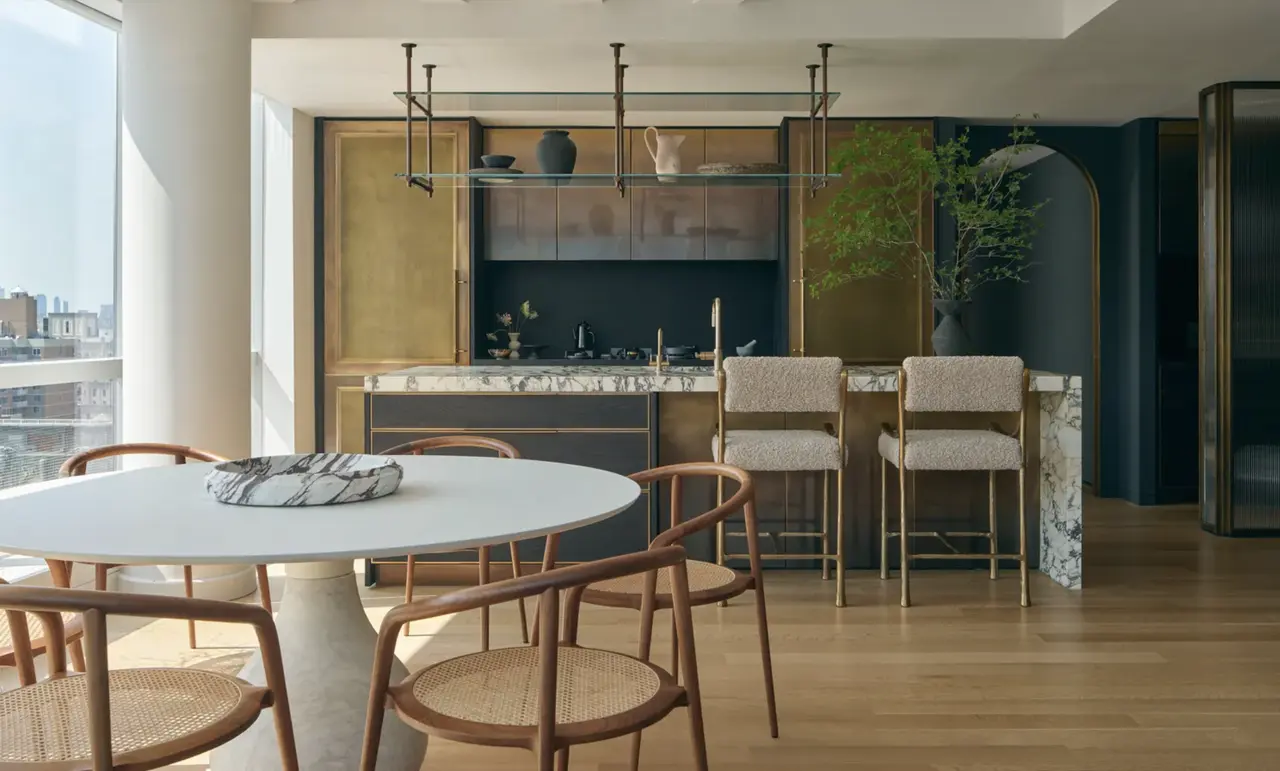9 Unique Ideas for Mixing Patterns in Your Home with Anne Carr Design
Mixing patterns in home decor can be intimidating, but with the right approach, it can create a visually stunning and harmonious space. Anne Carr Design is known for masterfully blending different patterns to craft unique interiors. In this blog, we'll explore nine creative ideas to help you mix patterns like a pro.
Understanding the Basics of Pattern Mixing
Before diving into pattern mixing, it's essential to grasp the basics. Understanding how color, scale, and style interact will form the foundation of successful pattern combinations. A pattern's scale refers to the size of the elements within it, while the style could range from traditional florals to modern abstract patterns. Once you have grasped these elements, mixing styles becomes less daunting, allowing for more creativity and personal expression. For instance, pairing a large-scale floral with a smaller geometric pattern can create a dynamic yet balanced look. Knowing the foundational principles of pattern mixing empowers you to make confident decisions about which elements to combine, resulting in a cohesive space.
It's important to remember that room functionality should guide your design choices. A busy kitchen might need more subdued patterns to avoid overwhelming the senses, while a bedroom could be a calming canvas where you can introduce bolder designs. Understanding color theory can also aid in harmonizing multiple patterns in a singular space. For example, selecting a triadic color scheme can weave different patterns together to create a unified aesthetic. This understanding not only makes the process enjoyable but enables you to craft exquisite interiors that reflect your unique style with Anne Carr Design's principles.
Choosing a Dominant Pattern
Start with a dominant pattern that sets the tone for the room. This can be a bold wallpaper, an intricate area rug, or a richly patterned piece of furniture that you build your design around. The dominant pattern should reflect your personal style and the ambiance you wish to create within the space. Selecting a statement piece as your anchor allows other design elements to complement and enhance it, further reinforcing your desired atmosphere. For instance, anchoring a living room with a paisley carpet in deep blues and greens can set a tranquil and sophisticated backdrop for the entire space.
When selecting your dominant pattern, consider its placement and visibility. A large central piece, like a patterned sofa or a feature wall, often works best as it naturally draws attention and sets the design stage. Once established, you can layer additional patterns that harmonize with or subtly contrast against the dominant one. This approach maintains a sense of balance while offering versatility in how patterns interact, blending seamlessly into the overall design vision of your home. Anne Carr Design emphasizes the importance of choosing pieces that speak to both aesthetic and functional needs, encouraging you to create spaces that reflect who you are.
Incorporating Complementary Colors
Select complementary colors from your dominant pattern and use them as a guide to introduce other patterns into the space. This approach ensures cohesion in your design. Complementary colors are opposites on the color wheel and, when used wisely, they can create a vibrant harmony that enhances the visual interest of a room. For example, pairing a deep navy pattern with accents of burnt orange adds warmth and dimension while maintaining visual coherency.
Besides creating visual appeal, incorporating complementary colors can help dictate the mood of a room. Soft, muted tones can produce a serene environment, while vivid, high-contrast colors might inject energy and excitement. If you are unsure about color combinations, draw inspiration from natural elements or artwork that resonates with you, making sure the selections relate back to your space's primary hues. This step allows for layered complexity, enriching your home’s visual narrative and connecting diverse patterns seamlessly.
Balancing Scale and Proportion
Mixing patterns requires careful consideration of scale. Pair larger patterns with smaller, more intricate designs to maintain balance and avoid overwhelming the space. The idea is to balance 'visual weight' within a room, creating a soothing yet dynamic arrangement. Large patterns attract immediate attention, serving as focal points, while smaller patterns intermingle to offer detail and texture.
Establishing a rhythm through varied pattern scales can evoke a sense of movement and flow in a room. For instance, juxtaposing a large botanical print with a smaller polka dot pattern on accent pillows can provide an engaging contrast that captures interest without feeling chaotic. Remember to distribute your chosen patterns evenly across the space to keep it visually balanced. Continually assess both symmetry and asymmetry in your designs to achieve the perfect fit for your interiors. Anne Carr Design suggests experimenting with different scales to uncover combinations that speak to your artistic sensibilities.
Layering Textures for Depth
Incorporate different textures alongside your patterns to add depth and dimension. Textured pillows, throws, and rugs can complement patterns and provide a tactile element to your decor. Layering textures involves deploying materials and finishes with varied tactile qualities, such as a plush velvet sofa coupled with a soft, nubby wool throw or a sleek glass table beneath a textured woven rug.
The key to successful texture layering lies in contrast. Strive to pair hard surfaces with soft furnishings, smooth finishes with rough textiles. This interplay of textures enriches a room, fostering a multidimensional aesthetic that captives both sight and touch. Textures work as a bridge among disparate patterns, unifying them and adding a sensory depth to their visual appeal. Utilize varied textures as a canvas to display your personality and as an avenue to explore creativity. Through Anne Carr Design's tips, feel encouraged to mix textures in bold, innovative ways, ensuring that your space feels both inviting and unique.
Using Neutral Patterns as a Neutral Base
Neutral patterns, such as stripes or subtle geometric designs, offer a versatile base that can tie various patterned elements together without competing for attention. The beauty of neutral patterns is their ability to ground a room, creating a harmonious backdrop suitable for bolder accents. Employing a neutral base allows the eye to rest amidst other striking and vivid designs within a given space.
Utilizing neutral patterns doesn't have to mean that you compromise on sophistication or warmth. Layering neutral-hued textiles and prints on furniture pieces can foster a sense of elegance and maturity within a room. In places like the living room, a neutral patterned area rug might be the cohesive element tying together an eclectic array of throw pillows or artwork. Anne Carr Design encourages you to see neutral patterns not just as fillers, but as essential components of your overall design strategy, bridging multiple styles and serving as the unifying thread that stitches together your eclectic decor tapestry.
Highlighting with Bold Accents
Utilize bold patterned accents sparingly to create focal points in the room. A vibrant vase or a striking cushion can draw the eye and provide a splash of personality. Bold accents are powerful tools in your design arsenal, capturing attention and adding dynamic energy to an area.
The key is to strike a balance between eye-catching design elements and the room's overall harmony. Too many bold pieces can overwhelm, but an occasional pop of vivid color or unexpected pattern can revitalize and transform a space. Carefully selecting where to place these items can help create distinct zones of interest and movement. By strategically introducing these vivid elements, Anne Carr Design aims to inspire creativity, encouraging you to explore the impact of daring focal accents in your personalized settings. Such style choices encourage pause and appreciation of your curated design elements while enriching your living space with charm and character.
Creating Flow Between Rooms
Ensure a seamless transition from one room to the next by repeating certain patterns or colors. This technique creates visual harmony throughout the home. Use of continuity in design acts as a bridge connecting distinct spaces, forming a cohesive overall aesthetic that captivates and reassures. It's the subtle echoes of similar patterns or colors—a stripe carried from the living room into the hallway in an understated way or a shared color palette that whispers its presence through different accessories—that fortify this connection.
Strategic repetition allows for a gentle guiding of guests' eyes through your home, enhancing their experience while reflecting an intentional style narrative. Such design continuity also aids in highlighting the distinctive features of each room, offering a sense of unity amid individuality. Anne Carr Design emphasizes the role of creating flow in cultivating a balanced living environment, where transitions from one area to another feel natural yet distinct. Through creativity and vision, crafting this inter-room dialogue becomes a testament to both your aesthetic tastes and functional needs.
Trusting Your Instincts
Ultimately, trusting your intuition and personal taste plays a crucial role in pattern mixing. Allow your creativity to guide you in creating spaces that feel authentic and inviting. Knowing when to follow conventions and when to break them is a delicate balance that ultimately leads to a home that represents your individuality and aesthetic preferences. Letting your instincts steer your design decisions helps weave a personal story throughout the spaces in your home, adding layers of meaning and involvement.
Experimentation leads to discovery; finding unexpected joys in combination confirms the creative freedom inherent to home design. Engage in feedback with the spaces you curate, letting comfort and inspiration serve as your paths. Anne Carr Design champions exploring these personal pathways, ensuring your home continues to be not just a physical dwelling, but an extension of who you are. Remember, the beauty of your home lies in how the space evolves with your tastes and needs, allowing you to pursue joy in pattern mixing while staying true to yourself.
Bringing It All Together
Mixing patterns adds character and depth to your home, transforming it into a truly personalized space. By following these tips from Anne Carr Design, you can confidently experiment with patterns and create rooms that reflect your unique style. Don't be afraid to mix and match, and remember that creativity has no bounds when it comes to home design.


